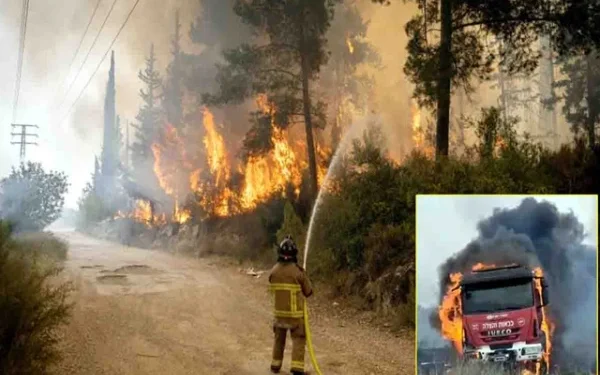Widespread Forest Fires Ignite in Central Israel
TEL AVIV – Central Israel was plunged into a state of emergency as two massive forest fires erupted in quick succession, posing a significant threat to human life, infrastructure, and the environment. These fires, described as among the most dangerous the country has seen in years, have affected areas in the suburbs of Jerusalem and the Shefela region.
Eshtaol Forest Blaze: Evacuations Ordered as Fire Spreads Rapidly
The most alarming blaze began in the Eshtaol Forest, located near the entrance to Moshav Tarum. Fueled by dry conditions and strong winds, the fire spread rapidly towards neighboring settlements, including Mesilat Zion and other nearby residential areas. The flames engulfed large stretches of land, burning dozens of vehicles and endangering homes.
Jerusalem Fire District Commander Shmuel Friedman immediately issued evacuation orders for all residents in the affected areas, emphasizing the urgent need to vacate homes for safety. The fire has reportedly reached the perimeters of residential zones, prompting a full-scale response from emergency services.
Massive Firefighting Response Deployed
In an aggressive bid to contain the flames, approximately 50 firefighting teams have been deployed. These teams include four aerial firefighting planes, one helicopter, and specialized units such as the Lehava unit and Keren Kayemeth LeIsrael (KKL) teams. Emergency responders from multiple districts are currently engaged in joint efforts to bring the situation under control.
Reinforcements are on the way, with an additional 20 firefighting units dispatched to the scene. Authorities are leveraging every available resource to prevent the fire from reaching more populated zones.
Traffic Chaos: Route Closures and Travel Restrictions
Due to the severity of the blaze in the Eshtaol area, authorities have shut down Route 44 in both directions to facilitate emergency access and prevent civilian entry into dangerous zones. Officials are also considering the temporary closure of Route 1, one of the main highways connecting Jerusalem and Tel Aviv.
Residents and commuters have been urged to avoid the region entirely. Emergency alerts and notifications have been sent out across media channels, warning of potential further disruptions.
Second Major Fire Breaks Out in the Shefela Region
As if one major incident weren’t enough, a second forest fire erupted in the Shefela area, located between the settlements of Pitahaya, Pedaya, and Givatun, near Route 6. This fire has intensified significantly in a short span of time, raising concerns about simultaneous large-scale blazes in relatively close proximity.
Authorities quickly moved to shut down Route 6 between the Nisharim and Sorek interchanges. The situation was deemed too dangerous for vehicular traffic as thick smoke and fast-moving flames made driving hazardous.
Train Services Suspended in Multiple Areas
Adding to the disruption, Israel Railways announced the temporary suspension of train services in several cities due to fire risks and visibility issues. The affected stations include Ramallah, Beit Shemesh, Meskiret Batya, Kiryat Malachi-Yavu, Kiryat Gat, and Lahavim-Rahat.
Railway officials, in collaboration with emergency services, deemed it unsafe to continue operations due to the proximity of the fires to train tracks and key transportation infrastructure.
Evacuation and Emergency Measures Expand
As of the latest updates, the fires at both Eshtaol and Shefela have not been fully contained. Emergency personnel are bracing for additional evacuations if containment efforts falter. Hospitals and emergency shelters in the Jerusalem and Tel Aviv areas are on high alert, with emergency care units prepared to handle incoming cases of smoke inhalation and burns.
Environmental Impact and Fire Conditions
Meteorological conditions—dry air, high temperatures, and strong winds—have created a perfect storm for forest fires. The Eshtaol and Shefela regions, known for their dense greenery and forested landscapes, have become tinderboxes in the wake of a prolonged dry season.
Environmental experts have warned that these fires could lead to significant ecological damage, including the destruction of habitats, wildlife displacement, and long-term air quality issues.
Government and Public Safety Response
Israel’s National Security Council has convened an emergency session to assess the situation and coordinate further actions. Prime Minister Benjamin Netanyahu has been briefed on the developments and has pledged full government support to firefighting and rescue operations.
Public safety agencies are broadcasting emergency preparedness messages, urging citizens to follow evacuation orders, remain indoors if in affected areas, and keep emergency kits ready.
Historical Context: Israel’s Battle with Wildfires
Israel has a history of dealing with wildfires, especially during the dry summer months. Notable past incidents, such as the Carmel Forest fire in 2010, which claimed 44 lives, have pushed authorities to refine their response strategies. The current fires, however, may represent the most dangerous dual outbreaks in recent memory due to their timing and scale.
Public Reaction and Volunteer Support
Civilians and local volunteers have rallied to support emergency services. From offering shelter to displaced individuals to providing food and logistical assistance to fire crews, the community has shown strong solidarity in the face of adversity.
Social media platforms are flooded with updates, calls for help, and coordination efforts to assist those affected. Several non-profit organizations and municipalities have opened helplines for evacuees.
Looking Ahead: Firefighting Efforts Continue
With fires still raging in multiple locations, firefighting teams are working around the clock. Authorities continue to monitor wind patterns and other meteorological data to anticipate changes in fire behavior. Drones and satellite imagery are being employed to assess damage and guide response teams more effectively.
Authorities emphasize that the public should remain vigilant and heed all safety warnings. The coming days will be critical in determining the full impact of these forest fires and the success of containment efforts.
Conclusion
The dual forest fires in Eshtaol and Shefela regions have triggered a nationwide response, highlighting the urgent need for coordinated disaster management in the face of climate-driven emergencies. As emergency teams strive to contain the fires, public cooperation and preparedness remain vital in ensuring the safety of lives and infrastructure across Israel.

























